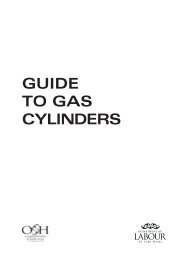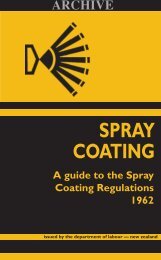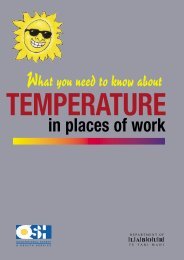Underground Petroleum Storage Tanks and Related Wastes - Code ...
Underground Petroleum Storage Tanks and Related Wastes - Code ...
Underground Petroleum Storage Tanks and Related Wastes - Code ...
You also want an ePaper? Increase the reach of your titles
YUMPU automatically turns print PDFs into web optimized ePapers that Google loves.
11.5 above). This in turn determines the cutting method selected. The preferred<br />
method of opening up tanks is by cold cutting, as even products that are normally<br />
nonvolatile can produce explosive vapour when heat is applied.<br />
A report on the condition of the tank, including the size <strong>and</strong> location of any holes<br />
that may be found, must be recorded in the form required by the principal <strong>and</strong> as<br />
advised by the project engineer.<br />
Oxygen under pressure is not safe with petroleum products or other hydrocarbons.<br />
Spontaneous combustion will occur in certain conditions. Do not use high<br />
pressure oxygen to clean scale or dirt from areas of tanks to be cut.<br />
11.11 Method<br />
At the time of processing, no more than one tank will be permitted on the disposal<br />
pad. The tank should be stripped of all fittings, <strong>and</strong> vents <strong>and</strong> manhole covers<br />
removed allowing the tank to vent. It should be lifted slightly at one end <strong>and</strong> any<br />
product <strong>and</strong> sludge air pumped or vacuumed out into prepared drums/containers.<br />
<strong>Tanks</strong> in storage <strong>and</strong> tanks on the disposal pad shall be regarded as dangerous<br />
goods Class 3(a) <strong>and</strong> the particular rules requiring an isolation distance of 15<br />
metres from any source of ignition shall be followed.<br />
The tank shall then be rendered inert by either filling with water or by one of the<br />
other methods outlined in sections 11.4 <strong>and</strong> 11.5. If the tank is not filled with<br />
water, it is essential to have to h<strong>and</strong> an approved intrinsically safe vapour tester<br />
<strong>and</strong> certified operator during the processing, to monitor the status of the tank. It is<br />
also essential to allow the tank to cool before testing for vapour — most<br />
explosimeters only operate satisfactorily at normal temperatures.<br />
An opening of 1 m2 minimum should be cut in the top side of the tank, or the<br />
whole of one end removed.<br />
Always work from outside <strong>and</strong> on the top side of the tank — never from inside,<br />
<strong>and</strong> never from the end. If the tank explodes it will almost invariably blow the<br />
ends out. It is not acceptable to crush tanks even when the ends have been cut out.<br />
Experience has shown that explosive cavities can be formed which cause dangers<br />
to the on processor. It also makes it impossible to deal with the scrap metal as<br />
specified in Octel Instruction Publication No. 5 — 01/92.<br />
A Lower Flammable Limit reading will only be given from a Class 3(b) or 3(c)<br />
tank (e.g. kerosene, diesel or fuel oil) after it starts to fume. Where a Class 3(b) or<br />
3(c) tank is badly holed <strong>and</strong> cannot be filled with water it should be purged with<br />
steam. The expelled air from inside the tank should be monitored at the time of<br />
hot cutting.<br />
11.12 Tank Entry<br />
Before anyone enters a tank or other confined space a competent person must<br />
inspect <strong>and</strong> test the confined space <strong>and</strong> issue a Confined Space Entry Permit<br />
listing any specific precautions that must be taken. These will include full breathing<br />
apparatus where there is any possibility of oxygen deficiency or petroleum or<br />
other toxic vapours, <strong>and</strong> personal protective equipment to suit the circumstances.<br />
See also section 13 Special Hazards.<br />
Transport <strong>and</strong> Disposal of <strong>Petroleum</strong> <strong>Storage</strong> <strong>Tanks</strong> 21





